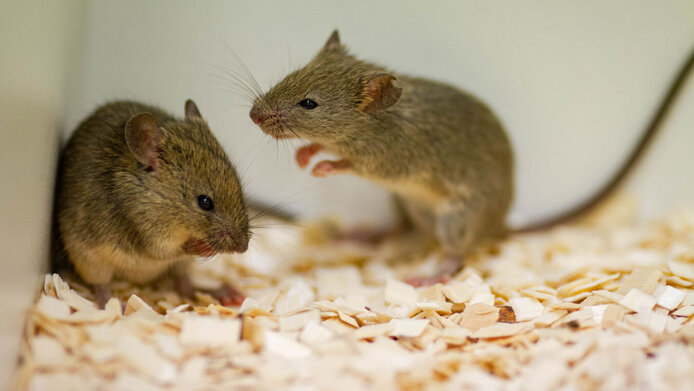Eavesdropping on courtship messages

Some animals break into song to woo a mate: even whales do so underwater, inaudible for us. The great variety of early-morning birdsong is far more obvious. And now we know that even male mice can do more than just squeak. Many years ago, researchers at the Konrad Lorenz Institute were among the first to record ultrasonic calls of laboratory mice during courtship and mating, which is inaudible to humans. It has been known for about 15 years that these sound sequences are similar in complexity to birdsong. In fact, the ultrasonic vocalisations (USV) of mice even sound not unlike birdsong when slowed down enough to become audible, explains Dustin Penn from the Konrad Lorenz Institute of Ethology at the University of Veterinary Medicine Vienna (VetMed). In collaboration with Sarah Zala and VetMed students, Penn conducted initial studies with wild house mice, which gave rise to a research project funded by the Austrian Science Fund FWF. The objective was to understand the behavioural function of the USVs.
So as to be able to work with wild house mice in the first place, the researchers first had to capture parent animals in stables. Their research work was subsequently conducted with the offspring in order to control the conditions and to be able to keep track of parameters such as age and relationship. It is difficult to coax a wild house mouse into a singing mood, notes Dustin Penn. Important findings in this regard were collected during the research project.
Automating audio analysis
The team recorded the USVs of male mice, characterised them and played the recordings to female mice, observing their behaviour and mating success. One important finding of these “eavesdropping campaigns” in the service of science is that male mice can be identified by their vocalisations. In these studies, females were found to be more attracted to males of their own species and to the calls of unrelated males than they were to those of their own brothers. In order to explore how the USV messages work and what their purpose is, the normally inaudible mating calls first had to be reliably recorded and then analysed in an automated process.
Making these recordings was a technical challenge. The ultrasound range required the use of special microphones and loudspeakers. The evaluation of the vocalisations in the form of spectrograms (a pictorial representation of the amplitude of different frequencies as a function of time) is challenging and time-consuming and still involves manual recording in most studies. Ten minutes of recorded mouse vocalisations can contain up to one thousand individual USVs, which vary in length, vibration and loudness. Classifying these USVs takes hours. In order to develop better methods for characterising the collected recordings, the team worked closely with Peter Balazs of the Acoustics Research Institute at the Austrian Academy of Sciences. “We worked together to develop a new tool, the Automatic Mouse Ultrasound Detector (A-MUD), which can automatically detect and record USVs. Right now we are working on a tool that will automatically classify the USV spectrograms and thus make evaluation and analysis more efficient,” says Penn.
Acoustic fingerprint and successful mating
Why do mice emit such information in the ultrasonic range in the first place? Some predators after all are quite capable of picking up such sounds. In fact, the explanation is to be found in their body size: the small distance between their ears means that the only sound sources mice can accurately localise are those with low wavelengths. For rodents and bats, ultrasound is therefore a good choice, whereas elephants can even use infrasound: very low, long-wave frequencies that are transported over long distances.
By eavesdropping on mating calls, Dustin Penn’s team has already succeeded in providing evidence of individual characteristic signatures, in other words an “acoustic fingerprint” of individual males. Previously, it had been assumed that the animals recognise each other primarily by smell: “If we try to understand how animals search for their mates and analyse only attractants, we miss important messages,” says Penn, an expert on pheromones and mate choice. “A second important finding is that male mice adapt their sounds: the duration and complexity of courtship calls were more pronounced when males and females were unrelated, which is ultimately important for reproductive success.”
A follow-up project will now focus on how the mice integrate in their brain two different sensory perceptions, scent and audio signals, and use them for mate selection. Another FWF project will explore how the mice use USV to identify individuals.
Personal details
Dustin Penn studied biology with a focus on zoology at the Universities of Central Oklahoma, Florida and Utah (USA). In 2004 he acquired professorial qualification at the University of Vienna’s Department of Zoology. Between 2002 and 2014, he headed the Konrad Lorenz Institute of Ethology at the University of Veterinary Medicine Vienna, where he has been group leader at the Department of Interdisciplinary Life Sciences since 2015. The basic research project “Adaptive functions of ultrasonic vocalisations in male mice” (2015–2020) was funded by the Austrian Science Fund FWF with EUR 338,000.
Publications
Abbasi R., Balazs P., Marconi MA, Nicolakis D., Zala SM, Penn DJ: Capturing the songs of mice with an improved detection and classification method for ultrasonic vocalizations (BootSnap), in: bioRxiv (Preprint), 2021
Marconi MA, Nicolakis D., Abbasi R., Penn DJ, Zala SM: Ultrasonic courtship vocalizations of male house mice contain distinct individual signatures, in: Animal Behaviour 2020
Nicolakis D., Marconi MA, Zala SM, Penn DJ: Ultrasonic vocalizations in house mice depend upon genetic relatedness of mating partners and correlate with subsequent reproductive success, in: Frontiers in Zoology 2020
Zala SM, Reitschmidt D., Marconi MA, Noll A, Balazs P., Penn DJ.: Primed to vocalize: wild-derived male house mice increase vocalization rate and diversity after a brief encounter with a female, in: PLOS ONE 2020







